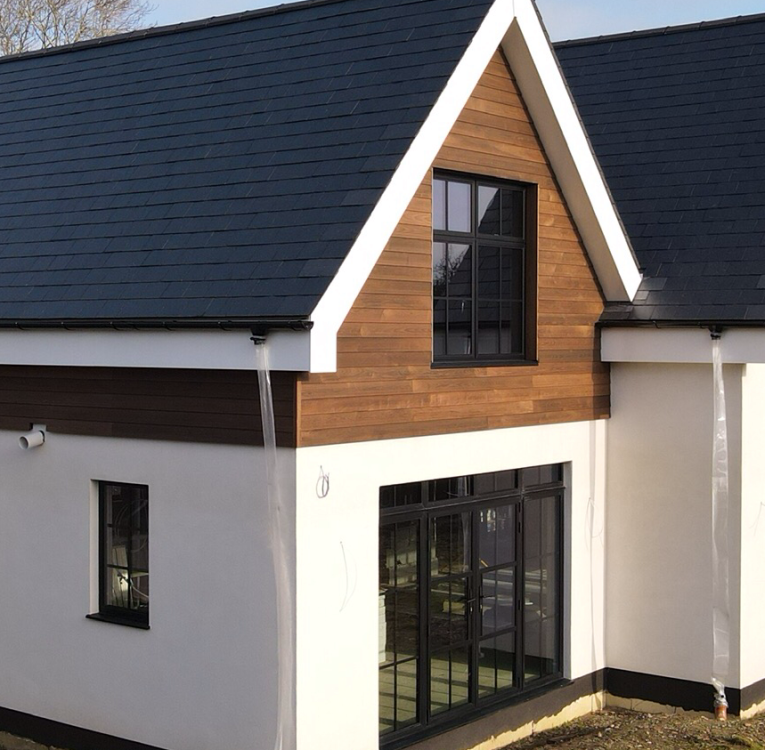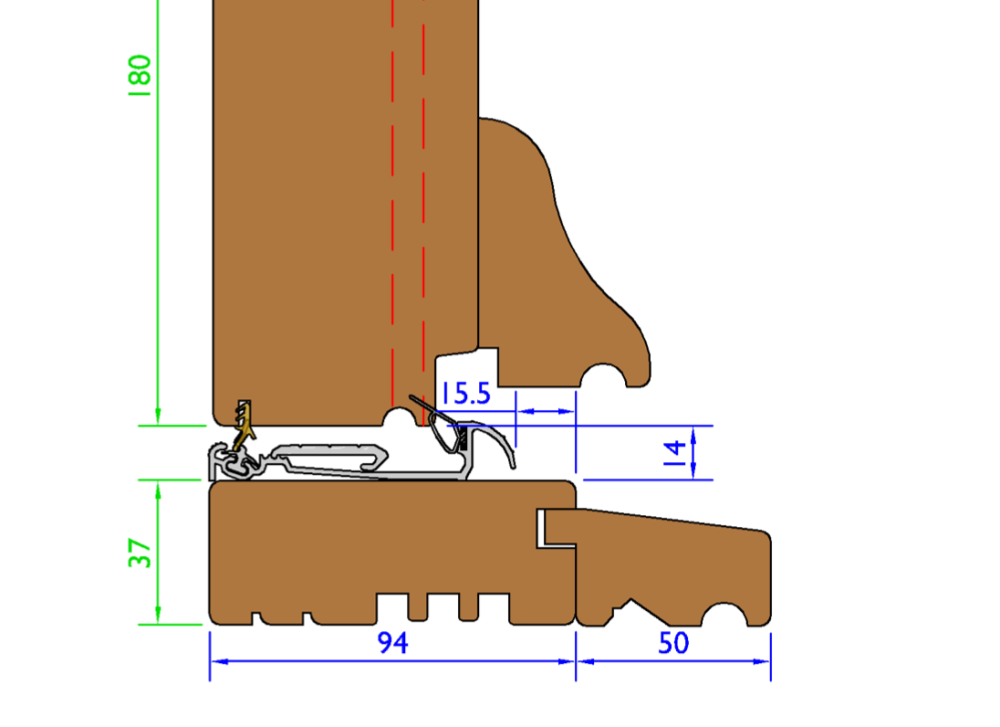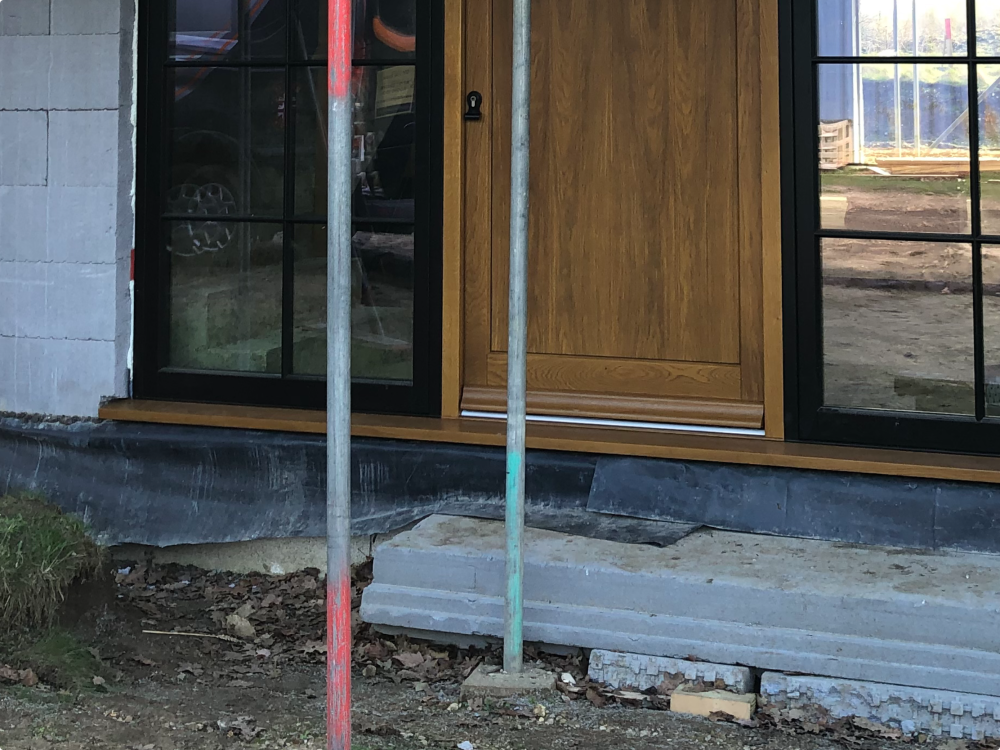
Nick Laslett
Members-
Posts
539 -
Joined
-
Last visited
-
Days Won
1
Nick Laslett last won the day on February 11
Nick Laslett had the most liked content!
Recent Profile Visitors
The recent visitors block is disabled and is not being shown to other users.
Nick Laslett's Achievements

Regular Member (4/5)
275
Reputation
-
@flanagaj, we have Thermowood Ash from QTD. https://www.qtdgroup.com/cladding This material will lose all its colour and go grey just like normal timber cladding. The advantages of the Thermowood vs normal timber are: 1. Dimensional stability 2. Greater resistance to insects and fungi. That is it. Downsides: 1. Cost 2. Installation time. Thermowood needs pilot holes and is fixed with screws. You can’t use nails, the timber is very dry and splits easily. If you use timber paint on thermowood, it will last a lot longer as the thermowood does not expand and contract as much as traditional cladding, so the paint doesn’t crack as easily. We used Osmo Clear UV oil for first year, but that stuff only lasted a year before needing a re-coat. Considering OSMO tinted UV oil this year. Or going with a paint. This has also been recommended. https://rubiomonocoat.co.uk/durogrit Picture of when it was first installed. I will post a more recent one later.
-
@Drellingore, I used the Stroma SAP software to do my “as designed” submission in 2021. This was a free download at the time. Here is a good thread discussing various approaches to SAP This thread links to the current download I think. Then this is another good discussion about using the Stroma software. You needed to edit the PDF output to remove the DRAFT watermark.
-
MVHR and cooling
Nick Laslett replied to flanagaj's topic in Mechanical Ventilation with Heat Recovery (MVHR)
@Dave Jones, my expectations are so low at this point, that it will be hard to be disappointed! -
Aluminium Vs Alic-Clad timber windows cost difference
Nick Laslett replied to flanagaj's topic in Windows & Glazing
I really rated the Senior Architectural PURe line, well engineered frames. They are a relative newcomer to the domestic market, but very strong in Commercial buildings. https://www.seniorarchitectural.co.uk/senior-opens-doors-into-the-domestic-market/ -
Aluminium Vs Alic-Clad timber windows cost difference
Nick Laslett replied to flanagaj's topic in Windows & Glazing
@flanagaj, this is an area where you could potentially save some money. You can get good u-values from 2g windows. For aesthetics we had to go with 2g, we wanted the crittall style look and steel windows are another level of expense. Our windows are only 1.3 u-value, but the coating on the inner leaf of the outer pane is what makes all the difference to how the window feels. This is a pretty standard thing to have and it helps reflects back your body heat. We have Smart Alitherm Heritage windows. A lot of companies use their systems but market them under different names like Duration and Cherwell. In the UK windows market you have system manufacturers, underneath them you have local fabricators, then you have installers/retailers. Sometimes the installer will also be the fabricator. The fabricators supply the local retailers. There are many exceptions to this. You could have the best window system, but be let down by the fabricator or installer or both. This website does good coverage of the aluminium windows market and will list a lot of system manufacturers. https://www.doorandwindowexperts.co.uk/aluminium-windows/who-makes-the-best-aluminium-windows/ -
That sounds great. Next Thursday works for me. Thank you for hosting.
-
@zzPaulzz, I agree with Alan, your build is at an interesting stage. I would love to take a look.
-
Insulated threshold detail for insulated rafts
Nick Laslett replied to WannabeBob's topic in General Construction Issues
We have used George Barnsdale for our front & back doors. This is an example of the cill detail, ignore the measurements. The 94mm door frame sat on the 150mm concrete core of the ICF block. Then we have a cill extension piece extending over the outer leaf of EPS by about 25mm. My understanding is that this would usually be fixed with a screw from the bottom going into the frame from the outside. They were unable to do this, because the EPS was in the way, so they screwed the cill extension piece from the inside through the door frame. Hope that makes sense. For out French doors, these are aluminium and have aluminium cills large enough to protruded past the EPS. -
Are these MVHR numbers correct?
Nick Laslett replied to SBMS's topic in Mechanical Ventilation with Heat Recovery (MVHR)
This is the thread I was thinking of with an excellent post from @HerbJ breaking down the MVHR numbers for another member. -
Are these MVHR numbers correct?
Nick Laslett replied to SBMS's topic in Mechanical Ventilation with Heat Recovery (MVHR)
BR requirement for supply is based on no. bedrooms. That is what you see in the first line of the Paul quote. BR uses a different criteria for extract. There is possibly an “and/or” requirement in BR to satisfy the criteria. MVHR are not designed to satisfy UK building regs, but to give you a pleasant house environment (forgive gross oversimplification). But if you install the right MVHR unit it will comply with both Building Regs. The MVHR thread here does explain it, and the spreadsheet notes cover the calculations in detail. Just like the heat loss topic, you can do your own calculations. I will find the link. First post has the MVHR_sizing spreadsheet, and ventilation building regs document. This is what I posted in 2020 to help myself to understand the building regs requirements circa 2020. This was from the Vent Asia website at the time. -
Are these MVHR numbers correct?
Nick Laslett replied to SBMS's topic in Mechanical Ventilation with Heat Recovery (MVHR)
This is a complicated topic. My memory from the research I did here back in 2019/20, was that for building regs the MVHRs were turned up quite high, but once the dwellings were being lived in, the MVHR was turned down. This was stated by at least three members here. This is what they imply with the statement commissioned on Level 3 for ventilation requirements. The supply requirements are less stringent, which is why you see the two ventilation numbers, one for BR using the number of bedrooms, the other is a Passive House standard. -
MVHR, A/C and ComfoPost all need condensate drains, The planning and installation of all this stuff is where the professionals can really add their value. Many different ways to route all this stuff, but really helps if you design it in from the beginning. Same with the external blinds. Just look at villas in Provence or Tuscany, they all have thick stone walls, small south facing windows with external timber shutters. If you can design in motorised external shutters, this would solve this problem. Won’t suit all house styles. Good video on this topic.
-
This is the Fancoil thread I have bookmarked. Panasonic have Fancoils and ASHPs.
-
Material choice for barge boards (capped), soffits and fascias
Nick Laslett replied to zzPaulzz's topic in General Joinery
My vote: Timber covered/capped with Aluminium. My neighbour has Cedral. Impossible to love. Hard redline for wife & I. Tricoya is amazing. James Latham will sell you Tricoya by the pallet, massive decrease in price per board, but far too much material. Do not do what we did. I baulked at the price and work fittings timber covered aluminium like the Marley Alutec system. Basically with Alutec you fit the timber, then you fit the aluminium, so in my ignorance I decided that meant you were doing the work twice. In my defence, the Thermohouse roof boards are so thick, that you need fascia boards taller than the off the peg PVC/Aluminium boards, 460mm. As with most of my build decisions, I decided to go off-piste and make up my own system. We used Medite Exterior MDF, supplied by Latham’s for the fascia boards. We used 12mm cement board for the soffits. All painted using the Dulux Weathershield system. It took us 6 months to cut, paint and install all these boards. Medite’s technicals on Exterior MDF require 7 coatings on both sides of the MDF. 1. Seal all edges with MDF sealer - 2 coats 2. Dulux Trade Weathershield Preservative Primer + (BP) - 2 coats 3. Dulux Trade Weathershield Exterior Flexible Undercoat - 2 coats 4. Dulux Trade Weathershield Exterior High Gloss - 1 coat (but in reality 2nd coat once fitted. ) Each board took 7 days to turn around. -
MVHR and cooling
Nick Laslett replied to flanagaj's topic in Mechanical Ventilation with Heat Recovery (MVHR)
Good thread about the ComfoPost






